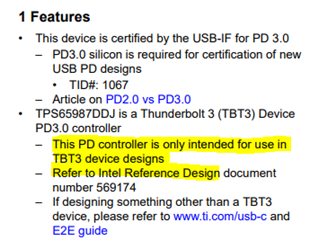Other Parts Discussed in Thread: TPS65981, TPS65987
Tool/software:
We used the TPS65987DDJ on our board for charging various devices, such as smartphones and laptops, We don't use flash near the chip, and we want to configure the chip using a microcontroller with I2C. However, I can't configure the chip with the 'TPS65981_2_6_7_8 Application Customization 6.1.4' application. And we configure the chip via I2C with the configuration below:
| register address | data len | value |
| 0x6 | 8 | 0x0 |
| 0x27 | 14 | 0x7800000014140080000900090001 |
| 0x28 | 5 | 0x1dfb658c9 |
| 0x29 | 4 | 0x40110402 |
| 0x32 | 64 | 0x190000000000000000000000000000006412c0004b12c0002d12c0101912c000000550000fc04 |
| 0x33 | 57 | 0x1900000 |
| 0x42 | 4 | 0x41a |
| 0x47 | 49 | 0x70020027c00000000000000000000000000000000001234070020027c00c440045103 |
| 0x51 | 7 | 0xb0c1c4603 |
| 0x55 | 1 | 0x4 |
| 0x5c | 64 | 0xa0000090008070000000000000000000000270329000000000000000000000000000000080000000000000000000000000012c007 |
| 0x73 | 26 | 0x12340451 |
| 0x77 | 24 | 0x3c0000000000000000000000000001010000000012340451 |
these values are default standard profile for tps65987DDH( tps65987DDJ not exist in application).
So, when we don't configure the chip, it charges a smartphone with 5V and 1A, but it doesn't work for a laptop because the laptop needs 20V. However, when we configure the chip via I2C, the charger doesn't work even for the mobile. We connect PP_HV1 and PP_HV2 in the schematic.
I don't know what our problem is; please guide me.



